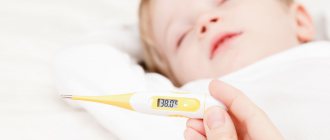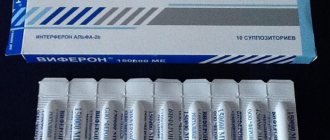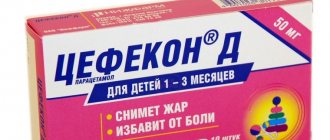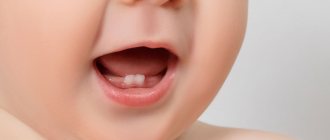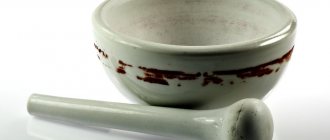Normal body temperature in children under one year of age
The thermoregulation system is formed by the end of the baby’s first year of life.
After the mother's womb, the child undergoes adaptation to an external environment that is completely different from the mother's womb. The newborn's body learns to sense different influences, thereby forming a reaction to heat, cold and food. Immediately after birth, the following are considered normal indicators:
—
when measured in the armpit - up to 37.5°C;
—
in the mouth – up to 37.3°C;
—
with rectal measurements – up to 37.7°С
As the thermoregulatory system is established, the indicators approach the usual measurements:
- from 1 to 3 months – 36.8 – 37.7 °C
- from 4 to 6 months – 36.3 – 37.5 °C
- from 7 to 12 months – 36.0 – 37.2 °C
How to reduce a child's temperature?
Doctors advise using only one drug from the above - with Paracetamol or Ibuprofen in the composition. If the temperature drops poorly or does not drop at all, such medications can be alternated. But you can’t give your baby the combined drug Ibuklin.
Please note that it is not at all necessary to reduce the temperature to normal. It is enough just to knock it down a little for the baby’s well-being to improve at least a little. Don’t forget to feed your little one, because in case of high temperature the loss of fluid increases. Pediatricians say that babies need to drink 100 ml of water per 1 kg of weight.
Reasons for rising temperature
1.
Eating.
A slight rise in temperature is possible during meals or within 1 - 2 hours after, since the baby spends a lot of strength and energy to produce milk and to digest food. 2.
Overheating.
Parents very often wrap their child up, which is something they shouldn’t do. 3.
Vaccination.
After some vaccinations, a temperature jump may occur. 4.
Teething.
This is the most common cause of increased body temperature in infants due to swelling and inflammation of the gums. 5.
Thirst and dehydration.
It is important that the baby receives enough fluid, especially in the heat or when bottle-fed. Water deficiency is very dangerous for a baby's life. 6.
Infectious and inflammatory diseases. ARVI, colds.
Negative reactions of the body
When using the drug, negative reactions of the child’s body may occur. Most often they are expressed by malfunctions of the digestive system. This may include abdominal pain, nausea and vomiting.
In case of hypersensitivity to the active ingredient, there is a risk of allergies. It manifests itself
- Rash.
- Itching.
- Hives.
With prolonged use of suppositories, severe negative reactions of the body from the hematopoietic system are observed. Anemia occurs most often, but other pathological conditions that threaten the child’s health are also possible.
An overdose of the drug is dangerous. Its symptoms are pale skin, constant nausea that causes severe vomiting and abdominal pain. Within 12-48 hours, against the background of an overdose, signs of liver failure appear, which is life-threatening.
If you suspect an overdose, you should urgently call an ambulance. After cleansing therapeutic procedures, symptomatic treatment and strict monitoring of blood counts are prescribed.
How to measure a child's temperature
It is more correct to perform thermometry in a calm, preferably sleepy state.
The baby should be exposed or left only in a light vest. The duration of the procedure depends on the type of thermometer. Types of thermometers:
1.
Mercury thermometer.
This is the most accurate device. Measurements are taken in the armpit for 10 minutes, in the mouth and anus for 5 minutes. 2.
Electronic thermometer.
It is known for its fast measurement, and some models have a function to save the last result, which makes it possible to monitor temperature dynamics. 3.
Infrared thermometer.
It is easy to use. They need to swipe their forehead and get the exact numbers. There is also an ear model of such a thermometer, but it will show an unreliable result in case of inflammation of the auricle. 4.
Non-contact thermometer - for measuring without touching.
It is optimal for use in infants, especially during sleep. 5.
Dummy thermometer. A device for babies sucking a pacifier. The result will appear on the screen in just one minute.
Composition and type
The group of non-narcotic analgesics includes cefekon for children. The drug is produced in the form of white torpedo-shaped suppositories. This simplifies the process of using them. Some manufacturers may have a slightly creamy tint. Candles are sold in film blisters of 5 pieces. Two pieces fit into a cardboard box. Suppositories always come with instructions.
Cefekon d contains paracetamol in various quantities: 50, 100 mg, 250 mg. Thanks to this, you can choose exactly the medicine to use. An auxiliary substance that allows rectal suppositories to be given the desired shape is solid fat.
What temperature should be lowered in infants?
There are two types of fever - red and white.
With red hyperthermia, the child’s skin is pink, the palms and soles are warm, and the child’s behavior is normal. The temperature drops easily. With white fever, peripheral vascular spasm occurs. The skin turns pale, the arms and legs are cold. Body temperature can reach high values. The temperature is not going well. This condition is very life-threatening and often causes seizures. Therefore, with white fever, you need to bring down the temperature from 38.0°C. And if it’s towards night, and the temperature is clearly rising, then it’s better even with 37.8°C.
For red hyperthermia, in addition to antipyretic drugs, physical cooling methods should be actively used (wiping the baby’s back, tummy, legs and arms with a towel dipped in warm water).
With white hyperthermia, you need to act differently. First of all, you need to warm the child by rubbing the surface of the body with your hands. You can resort to physical cooling methods only after the skin has become pink and warm.
Special instructions
Before using Cefekon suppositories, you must carefully study the instructions for use. It is imperative to ensure that the amount of active substance used does not exceed the permissible daily allowance in accordance with the age and weight of the child.
If minimal side effects occur during treatment with the drug, you should stop using it and inform your doctor. It is important to exclude other paracetamol-containing drugs during treatment to avoid accidental overdose.
What to do with high values
1.
Maintain a favorable temperature in the room of 20 - 22°C and ventilate more often.
2.
Dress the child in light clothing.
3.
Drink plenty of warm drinks (breast milk, water).
If the baby is more than 6 months old, then give compote, herbal tea, fruit juice. 4.
Avoid active games.
5.
If the temperature rises significantly, you need to give an antipyretic drug based on paracetamol (Efferalgan, Panadol suspensions, Cefekon suppositories) or ibuprofen (Nurofen suspension).
Terms of use
Tsefekon are candles for children. They are used rectally only as prescribed by a doctor. The drug is prescribed with special caution for up to a year. Suppositories should not be divided to obtain the required dose.
Before administration, it is necessary to cleanse the rectum with an enema. Suppositories can also be administered after the child has had a natural bowel movement. The dose is calculated individually. The age and weight of the child are taken into account.
It is allowed to use 10-15 mg of the active component of the drug per 1 kg of weight. The daily dose should not exceed 60 mg/kg. Repeated use is allowed after at least 6 hours. When deciding to take the drug against the background of impaired renal function, the time interval between taking the drug is increased to 8 hours.
Cefekon suppositories for children can be used to reduce fever for 3 days, and for pain relief – for 5 days. Extension of the period of use of the drug is possible only after consultation with a doctor. Additionally, it will be necessary to monitor blood counts.
Pharmacodynamics and pharmacokinetics
Pharmacodynamics
Children's Cefekon has an analgesic and antipyretic effect. In the central nervous system, the drug causes a blockade of cyclooxygenase, thereby affecting the pain center and thermoregulation system. At the site of inflammation, the effect of paracetamol on cyclooxygenase is neutralized by cell peroxidase, which significantly reduces the anti-inflammatory effect. Cefekon does not negatively affect the gastrointestinal mucosa and water-electrolyte metabolism, that is, sodium water retention in the body is not observed.
Pharmacokinetics
The drug has high absorption and is quickly absorbed through the mucous membrane. Easily overcomes the BBB. Has high bioavailability. Distributed mainly in body fluids. Protein binding is insignificant (less than 10%). Metabolized in the liver. The maximum concentration of the drug in the blood occurs within 10-60 minutes after taking it. It is excreted by the kidneys in the form of inactive metabolites (sulfates and glucuronides).
Is it normal for babies to have a teething fever?
When teething, your baby may actually develop a fever. When a tooth moves inside the gum, its tissue is injured. The child is in pain and is nervous. And since the baby’s thermoregulation mechanisms are not yet perfect, his temperature can rise even in response to stress. Later, when baby teeth are replaced with permanent teeth, the child may also experience discomfort, but his temperature will remain normal.
However, an increase in temperature during teething may also indicate that the child is simply sick. When a baby is teething, his body experiences additional stress, so his immunity is weakened. Sometimes parents attribute a high fever to “teeth,” but at this time it is necessary to treat the viral infection.
Contraindications
Children under 1 month, hypersensitivity to paracetamol, chronic alcoholism. The drug should be prescribed with caution in diseases of the blood system, severe and liver dysfunction , genetically determined enzymatic absence of glucose-6-phosphate dehydrogenase.
Cefekon D - suppositories during pregnancy and lactation can be prescribed taking into account the benefits and risks for the pregnant woman and the child (fetus). Studies have not established the teratogenic, mutagenic and embryotoxic effects of paracetamol.
Price Tsefekon D, where to buy
The price of Tsefekon suppositories for children 0.25 g No. 10 varies within 60 rubles per package. The price of Tsefekon D suppositories 0.05 g No. 10 is 25 rubles, and 0.1 g No. 10 is 50 rubles per package. You can purchase the drug in most pharmacies in Moscow and other cities.
- Online pharmacies in RussiaRussia
- Online pharmacies in UkraineUkraine
- Online pharmacies in KazakhstanKazakhstan
ZdravCity
- Cefekon D rectal suppositories.
100 mg 10 pcs. JSC "Nizhpharm" 52 rub. order
Pharmacy Dialogue
- Tsefekon D suppositories 250 mg No. 10Nizhpharm JSC
57 RUR order
- Tsefekon D suppositories 100 mg No. 10Nizhpharm JSC
50 rub. order
- Tsefekon D suppositories 50 mg No. 10Nizhpharm JSC
26 RUR order
show more
Pharmacy24
- Cefekon D for children 0.25 g N10 suppositories VAT "Nizhpharm", Nizhny Novgorod, Russian Federation
39 UAH. order - Cefekon D for children 0.1 g No. 10 suppositories VAT "Nizhpharm", Nizhny Novgorod, Russian Federation
45 UAH order
PaniPharmacy
- Cefekon D suppository Supp. cefekon D 0.25g No. 10 Russia, Nizhpharm
41 UAH order
- Cefekon D suppository Supp. cefekon D 0.1g No. 10 Russia, Nizhpharm
48 UAH order
show more

